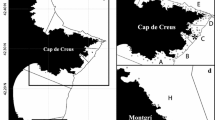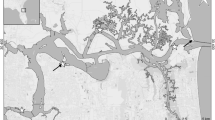Abstract
The sea cucumber, Cucumaria frondosa, is a benthic suspension feeder that captures food particles on its tentacles and then inserts them into its mouth one at a time. Previous studies have suggested that tentacle insertion rate (TIR) could be a useful indicator of food intake. The present study determined whether flow velocity affects TIR and whether TIR is a good indicator of ingestion. Video observations of sea cucumbers in Passamaquoddy Bay (45°01.70N, 66°55.74W) in August 1995 showed that TIRs increased with velocities up to 55 cm s−1 and decreased steadily at flows above that up to 130 cm s−1. In October 2006, laboratory flume studies were carried out on specimens collected from the same site in the previous August. Temperature and salinity (12°C and 32) in the flume were the same as in the field at the time of collection. There was high individual variation in feeding behavior at free-stream velocities of 4–40 cm s−1 and TIR was independent of flow. As the number of tentacle insertions increased in the flume experiments, the amount of chloropigments in the digestive tracts of the sea cucumbers also increased. This suggests that TIR, which can be measured non-intrusively using remote video techniques, could be a good indicator of feeding behavior and ingestion in C. frondosa.








Similar content being viewed by others
References
Anthony KRN (1997) Prey capture by the sea anemone Metridium senile (L): effects of body size, flow regime, and upstream neighbors. Biol Bull 192:73–86. doi:https://doi.org/10.2307/1542577
Bruckner AW (2005) The recent status of sea cucumber fisheries in the continental United States of America. SPC Beche-de-mer Inf Bull 22:39–46
Costelloe J, Keegan BF (1984) Feeding and related morphological structures in the dendrochirote Aslia lefevrei (Holothuroidea: Echinodermata). Mar Biol (Berl) 84:135–142. doi:https://doi.org/10.1007/BF00392998
Eckman JE, Duggins DO (1993) Effects of flow speed on growth of benthic suspension feeders. Biol Bull 185:28–41. doi:https://doi.org/10.2307/1542128
Fankboner PV (1978) Suspension-feeding mechanisms of the armoured sea cucumber Psolus chitinoides Clark. J Exp Mar Biol Ecol 31:11–25. doi:https://doi.org/10.1016/0022-0981(78)90133-8
Gosner KL (1978) Peterson field guides. Atlantic Seashore: a field guide to sponges, jellyfish, sea urchins and more. Houghton Mifflin Company, New York
Hamel J-F, Mercier A (1998) Diet and feeding behaviour of the sea cucumber Cucumaria frondosa in the St. Lawrence estuary, eastern Canada. Can J Zool 76:1194–1198. doi:https://doi.org/10.1139/cjz-76-6-1194
Hentschel BR, Larson AA (2005) Growth rates of interface-feeding polychaetes: combined effects of flow speed and suspended food concentration. Mar Ecol Prog Ser 293:119–129. doi:https://doi.org/10.3354/meps293119
Holland ND, Leonard AB, Meyer DL (1991) Digestive mechanics and gluttonous feeding in the feather star Oligometra serripinna (Echinodermata: Crinoidea). Mar Biol (Berl) 111:113–119. doi:https://doi.org/10.1007/BF01986352
Jordan AJ (1972) On the ecology and behavior of Cucumaria frondosa (Echinodermata: Holothuroidea) at Lamoine Beach, Maine. Ph.D. Thesis. University of Maine
Koehl MAR (1977) Effects of sea anemones on the flow forces they encounter. J Exp Biol 69:87–105
Lars-Ove L, Jonsson PR, Sköld M, Karlsson Ö (1996) Passive suspension feeding in Amphiura filiformis (Echinodermata: Ophiuroidea): feeding behaviour in flume flow and potential feeding rate of field populations. Mar Ecol Prog Ser 139:143–155. doi:https://doi.org/10.3354/meps139143
LaTour SA, Miniard PW (1983) The misuse of repeated measures analysis in market research. J Mar Res 20:45–57. doi:https://doi.org/10.2307/3151411
Leonard AB (1989) Functional response in Antedon mediterranea (Lamarck) (Echinodermata: Crinoidea): the interaction of prey concentration and current velocity on a passive suspension-feeder. J Exp Mar Biol Ecol 127:81–103. doi:https://doi.org/10.1016/0022-0981(89)90210-4
Leonard AB, Strickler JR, Holland ND (1988) Effects of current speed on filtration during suspension feeding in Oligometra serripinna (Echinodermata: Crinoidea). Mar Biol (Berl) 97:111–125. doi:https://doi.org/10.1007/BF00391251
Mann KH, Lazier JRN (2006) Dynamics of marine ecosystems: biological–physical interactions in the oceans. Blackwell Publishing, Malden
Newell CR, Wildish DJ, MacDonald BA (2001) The effects of velocity and seston concentration on the exhalant siphon area, valve gape and filtration rate of the mussel Mytilus edulis. J Exp Mar Biol Ecol 262:91–111. doi:https://doi.org/10.1016/S0022-0981(01)00285-4
NOAA, National Oceanic and Atmospheric Administration (2007) Obtained online http://tidesandcurrents.noaa.gov/index.shtml Last revised: 06/04/2007. Accessed 21 Dec 2007
Nowell ARM, Jumars PA (1987) Flumes—Theoretical and experimental considerations for simulation of benthic environments. Oceanogr Mar Biol 25:91–112
Potvin C, Lechowicz MJ, Tardiff S (1990) The statistical analysis of ecophysiological response curves obtained from experiments involving repeated measures. Ecology 71:1389–1400. doi:https://doi.org/10.2307/1938276
Robbins RE, Shick JM (1980) Expansion-contraction behavior in the sea anemone Metridium senile: environmental cues and energetic consequences. In: Smith DC, Tiffon Y (eds) Nutrition in the lower Metazoa. Pergamon Press, Oxford, pp 101–116
Shimeta J, Jumars PA (1991) Physical mechanisms and rates of particle capture by suspension-feeders. Oceanogr Mar Biol Ann Rev 29:191–257
Shimeta J, Koehl MAR (1997) Mechanisms of particle selection by tentaculate suspension feeders during encounter, retention, and handling. J Exp Mar Biol Ecol 209:47–73. doi:https://doi.org/10.1016/S0022-0981(96)02684-6
Singh R (1999) The feeding ecology and reproductive cycle of the sea cucumber Cucumaria frondosa (Gunnerus) from the Bay of Fundy. Ph.D. Thesis. University of New Brunswick
Singh R, MacDonald BA, Lawton P, Thomas MLH (1998) Feeding response of the dendrochirote sea cucumber Cucumaria frondosa (Echinodermata: Holothuroidea) to changing food concentrations in the laboratory. Can J Zool 76:1842–1849. doi:https://doi.org/10.1139/cjz-76-10-1842
Singh R, MacDonald BA, Thomas MLH, Lawton P (1999) Patterns of seasonal and tidal feeding activity in the dendrochirote sea cucumber Cucumaria frondosa (Echinodermata: Holothuroidea) in the Bay of Fundy, Canada. Mar Ecol Prog Ser 187:133–145. doi:https://doi.org/10.3354/meps187133
Smith TB (1983) Tentacular ultrastructure and feeding behaviour of Neopentadactyla mixta (Holothuroidea: Dendrochirota). J Mar Biol Assoc UK 63:301–311
Strickland JDH, Parsons TR (1972) In: Stevenson JC, Watson J, Reinhart JM (eds) A practical handbook of seawater analysis. Fisheries Research Board of Canada, Ottawa
Sutterlin AM, Waddy S (1976) Tentacle movement patterns involved in feeding behaviour of the sea cucumber, Cucumaria frondosa. Mar Behav Physiol 4:17–24. doi:https://doi.org/10.1080/10236247609386939
Therkildsen NO, Petersen CW (2006) A review of the emerging fishery for the sea cucumber Cucumaria frondosa: biology, policy, and future prospects. SPC Beche-de-mer Inf Bull 23:16–25
Wildish DJ, Miyares MP (1990) Filtration rate of blue mussels as a function of flow velocity: preliminary experiments. J Exp Mar Biol Ecol 142:213–219. doi:https://doi.org/10.1016/0022-0981(90)90092-Q
Wildish DJ, Saulnier AM (1992) The effect of velocity and flow direction on the growth of juvenile and adult giant scallops. J Exp Mar Biol Ecol 155:133–143. doi:https://doi.org/10.1016/0022-0981(92)90032-6
Wildish DJ, Kristmanson DD, Hoar RL, DeCoste AM, McCormick SD, White AW (1987) Giant scallop feeding and growth responses to flow. J Exp Mar Biol Ecol 113:207–220. doi:https://doi.org/10.1016/0022-0981(87)90101-8
Wildish DJ, Kristmanson DD, Saulnier AM (1992) Interactive effect of velocity and seston concentration on giant scallop feeding inhibition. J Exp Mar Biol Ecol 155:161–168. doi:https://doi.org/10.1016/0022-0981(92)90060-N
Zamer WE (1986) Physiological energetics of the intertidal sea anemone Anthopleura elegantissima: 1. Prey capture, absorption efficiency and growth. Mar Biol (Berl) 92:299–314. doi:https://doi.org/10.1007/BF00392670
Acknowledgments
We thank J. Martin at the St. Andrews Biological Station for providing collections of sea cucumbers and K. Cummings for helping maintain them in the laboratory. Dr. H. Hunt and M.J. Maltais provided the flume and assistance with the operations. Dr. R. Singh and W. Armstrong provided logistical and technical support. Drs. J. Kieffer and R. Rochette provided valuable input to the project and comments on earlier versions of the manuscript. This work was supported by grants from the Natural Science and Engineering Research Council of Canada. This research was conducted under certification through the University of New Brunswick and the Canadian Council for Animal Care. We appreciate their support.
Author information
Authors and Affiliations
Corresponding author
Additional information
Communicated by J. P. Grassle.
Rights and permissions
About this article
Cite this article
Holtz, E.H., MacDonald, B.A. Feeding behaviour of the sea cucumber Cucumaria frondosa (Echinodermata: Holothuroidea) in the laboratory and the field: relationships between tentacle insertion rate, flow speed, and ingestion. Mar Biol 156, 1389–1398 (2009). https://doi.org/10.1007/s00227-009-1179-0
Received:
Accepted:
Published:
Issue Date:
DOI: https://doi.org/10.1007/s00227-009-1179-0




